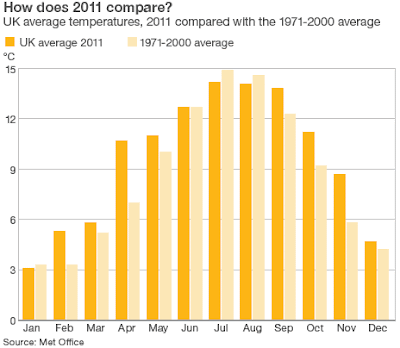So maybe I lied a little bit in my last post, and I will squeeze another short post in before the New Year. I came across this news article last night on the BBC, where the Met Office data shows that the average temperature for the entire year has been 9.62C in the UK. This makes it the second warmest year on record, only narrowly behind 2006 where the average temperature was 9.73C. The graph below compares this years temperatures to the 30 year average between 1971-2000. The most notable differences are seen in the spring months.
Only two weeks ago the government granted a drought order to South East Water as the dry conditions between September and November have dropped water levels at the Ardingly reservoir in Sussex to just 12%! Nine of the top ten warmest years on record have all actually occurred since 1997, with the seven warmest all occurring in the last decade. In the news article Dr. Huntingford (climate modeller) states:
"As each year passes and we hear that a warming record has been broken, or nearly broken again, it provides further evidence that unfortunately we are not just seeing a natural cycle of global warming, and that instead humans are having an effect on the climate."
Well, I can now officially say that I'm signing off for 2011. Wishing you all a very happy (and mild!) New Year!

























